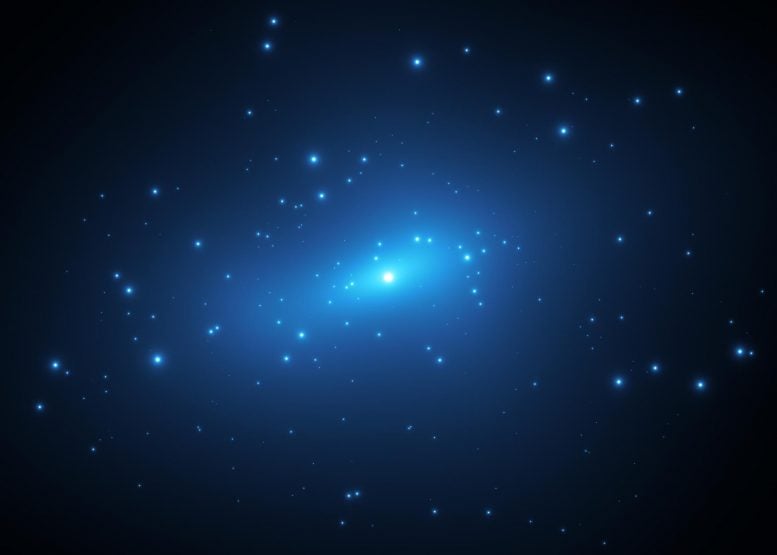
This artist’s impression represents small-scale concentrations of dark matter in the galaxy cluster MACSJ 1206. Astronomers measured the amount of gravitational lensing caused by this cluster to produce a detailed map of the distribution of dark matter in it. Dark matter is the invisible glue that keeps stars bound together inside a galaxy and makes up the bulk of the matter in the Universe. Credit: ESA/Hubble, M. Kornmesser
Observations by the NASA/ESA Hubble Space Telescope and the European Southern Observatory’s Very Large Telescope (VLT) in Chile have found that something may be missing from the theories of how dark matter behaves. This missing ingredient may explain why researchers have uncovered an unexpected discrepancy between observations of the dark matter concentrations in a sample of massive galaxy clusters and theoretical computer simulations of how dark matter should be distributed in clusters. The new findings indicate that some small-scale concentrations of dark matter produce lensing effects that are 10 times stronger than expected.
Dark matter is the invisible glue that keeps stars, dust, and gas together in a galaxy. This mysterious substance makes up the bulk of a galaxy’s mass and forms the foundation of our Universe’s large-scale structure. Because dark matter does not emit, absorb, or reflect light, its presence is only known through its gravitational pull on visible matter in space. Astronomers and physicists are still trying to pin down what it is.
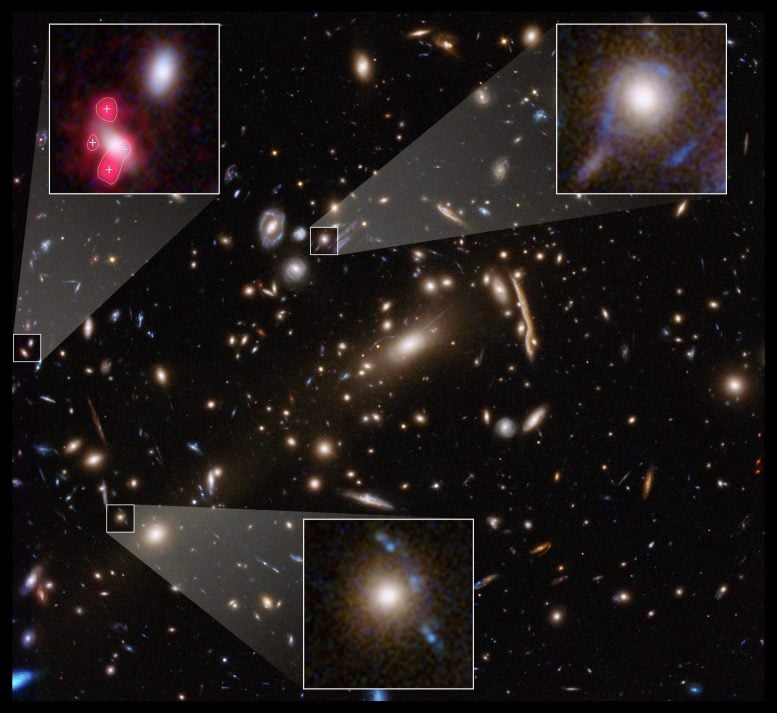
This Hubble Space Telescope image shows the massive galaxy cluster MACSJ 1206. Embedded within the cluster are the distorted images of distant background galaxies, seen as arcs and smeared features. These distortions are caused by the dark matter in the cluster, whose gravity bends and magnifies the light from faraway galaxies, an effect called gravitational lensing. This phenomenon allows astronomers to study remote galaxies that would otherwise be too faint to see.
Astronomers measured the amount of gravitational lensing caused by this cluster to produce a detailed map of the distribution of dark matter in it. Dark matter is the invisible glue that keeps stars bound together inside a galaxy and makes up the bulk of the matter in the Universe.
The Hubble image is a combination of visible- and infrared-light observations taken in 2011 by the Advanced Camera for Surveys and Wide Field Camera 3.
Credits: NASA, ESA, G. Caminha (University of Groningen), M. Meneghetti (Observatory of Astrophysics and Space Science of Bologna), P. Natarajan (Yale University), and the CLASH team.
Galaxy clusters, the most massive and recently assembled structures in the Universe, are also the largest repositories of dark matter. Clusters are composed of individual member galaxies that are held together largely by the gravity of dark matter.
“Galaxy clusters are ideal laboratories in which to study whether the numerical simulations of the Universe that are currently available reproduce well what we can infer from gravitational lensing,” said Massimo Meneghetti of the INAF-Observatory of Astrophysics and Space Science of Bologna in Italy, the study’s lead author.
This video begins with an image from the NASA/ESA Hubble Space Telescope of the massive galaxy cluster MACSJ 1206. Embedded within the cluster are the distorted images of distant background galaxies, seen as arcs and smeared features. These distortions are caused by the dark matter in the cluster, whose gravity bends and magnifies the light from faraway galaxies, an effect called gravitational lensing. This phenomenon allows astronomers to study remote galaxies that would otherwise be too faint to see.
The video then shows an artist’s impression of small-scale concentrations of dark matter (represented in this video in blue). Dark matter is the invisible glue that keeps stars bound together inside a galaxy and makes up the bulk of the matter in the Universe. These blue halos reflect how the galaxy cluster’s dark matter is distributed, revealed by new results from the Hubble Space Telescope. This was accomplished by a team of astronomers by measuring the amount of gravitational lensing.
Credit: NASA, ESA, G. Caminha (University of Groningen), M. Meneghetti (Observatory of Astrophysics and Space Science of Bologna), P. Natarajan (Yale University), the CLASH team, and M. Kornmesser (ESA/Hubble)
“We have done a lot of testing of the data in this study, and we are sure that this mismatch indicates that some physical ingredient is missing either from the simulations or from our understanding of the nature of dark matter,” added Meneghetti.
“There’s a feature of the real Universe that we are simply not capturing in our current theoretical models,” added Priyamvada Natarajan of Yale University in Connecticut, USA, one of the senior theorists on the team. “This could signal a gap in our current understanding of the nature of dark matter and its properties, as these exquisite data have permitted us to probe the detailed distribution of dark matter on the smallest scales.”
This video shows an artist’s impression of the phenomenon of gravitational lensing.
Credit: ESA/Hubble and M. Kornmesser
The distribution of dark matter in clusters is mapped by measuring the bending of light — the gravitational lensing effect — that they produce. The gravity of dark matter concentrated in clusters magnifies and warps light from distant background objects. This effect produces distortions in the shapes of background galaxies which appear in images of the clusters. Gravitational lensing can often also produce multiple images of the same distant galaxy.
The higher the concentration of dark matter in a cluster, the more dramatic its light-bending effect. The presence of smaller-scale clumps of dark matter associated with individual cluster galaxies enhances the level of distortions. In some sense, the galaxy cluster acts as a large-scale lens that has many smaller lenses embedded within it.
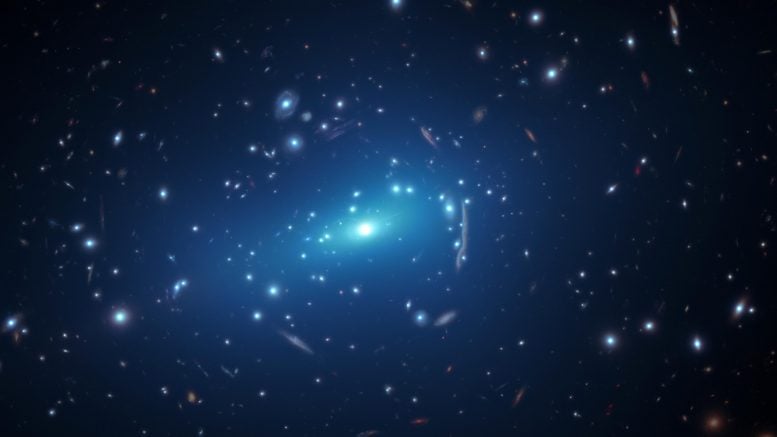
This NASA/ESA Hubble Space Telescope image shows the massive galaxy cluster MACSJ 1206. Embedded within the cluster are the distorted images of distant background galaxies, seen as arcs and smeared features. These distortions are caused by the dark matter in the cluster, whose gravity bends and magnifies the light from faraway galaxies, an effect called gravitational lensing. This phenomenon allows astronomers to study remote galaxies that would otherwise be too faint to see.
Overlaid on the image are small-scale concentrations of dark matter (represented in this artist’s impression in blue). Dark matter is the invisible glue that keeps stars bound together inside a galaxy and makes up the bulk of the matter in the Universe. These blue halos reflect how the galaxy cluster’s dark matter is distributed, revealed by new results from the Hubble Space Telescope. This was accomplished by a team of astronomers by measuring the amount of gravitational lensing.
Credit: NASA, ESA, G. Caminha (University of Groningen), M. Meneghetti (Observatory of Astrophysics and Space Science of Bologna), P. Natarajan (Yale University), the CLASH team, and M. Kornmesser (ESA/Hubble)
Hubble’s crisp images were taken by the telescope’s Wide Field Camera 3 and Advanced Camera for Surveys. Coupled with spectra from the European Southern Observatory’s Very Large Telescope (VLT), the team produced an accurate, high-fidelity, dark-matter map. By measuring the lensing distortions astronomers could trace out the amount and distribution of dark matter. The three key galaxy clusters, MACS J1206.2-0847, MACS J0416.1-2403, and Abell S1063, were part of two Hubble surveys: The Frontier Fields and the Cluster Lensing And Supernova survey with Hubble (CLASH) programs.
To the team’s surprise, in addition to the dramatic arcs and elongated features of distant galaxies produced by each cluster’s gravitational lensing, the Hubble images also revealed an unexpected number of smaller-scale arcs and distorted images nested near each cluster’s core, where the most massive galaxies reside. The researchers believe the nested lenses are produced by the gravity of dense concentrations of matter inside the individual cluster galaxies. Follow-up spectroscopic observations measured the velocity of the stars orbiting inside several of the cluster galaxies to therby pin down their masses.
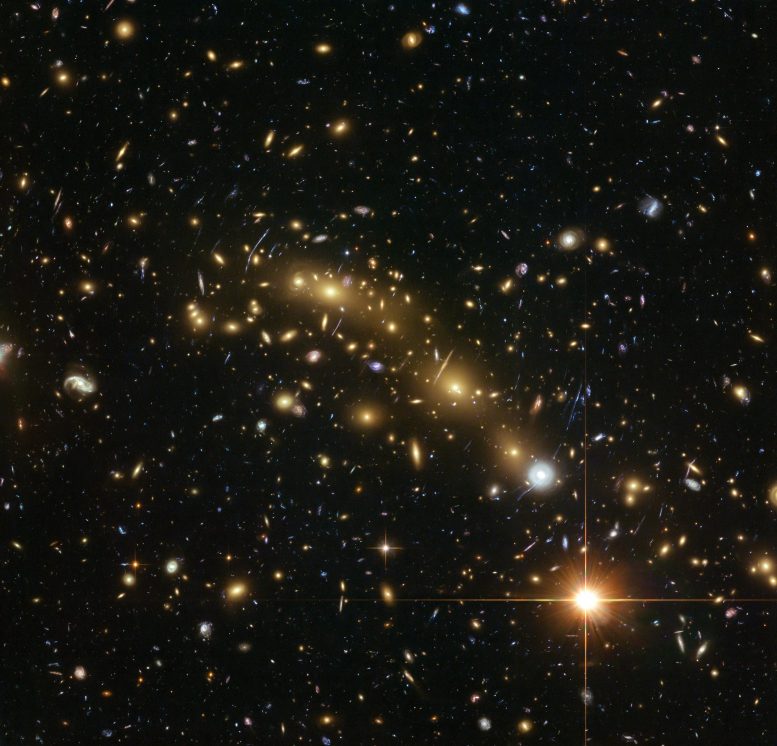
This image from the NASA/ESA Hubble Space Telescope shows the galaxy cluster MACS J0416.1–2403. This is one of six being studied by the Hubble Frontier Fields program. This program seeks to analyze the mass distribution in these huge clusters and to use the gravitational lensing effect of these clusters, to peer even deeper into the distant Universe.
A team of researchers used almost 200 images of distant galaxies, whose light has been bent and magnified by this huge cluster, combined with the depth of Hubble data to measure the total mass of this cluster more precisely than ever before.
Credit: ESA/Hubble, NASA, HST Frontier Fields Acknowledgement: Mathilde Jauzac (Durham University, UK and Astrophysics & Cosmology Research Unit, South Africa) and Jean-Paul Kneib (École Polytechnique Fédérale de Lausanne, Switzerland)
“The data from Hubble and the VLT provided excellent synergy,” shared team member Piero Rosati of the Università degli Studi di Ferrara in Italy, who led the spectroscopic campaign. “We were able to associate the galaxies with each cluster and estimate their distances.”
“The speed of the stars gave us an estimate of each individual galaxy’s mass, including the amount of dark matter,” added team member Pietro Bergamini of the INAF-Observatory of Astrophysics and Space Science in Bologna, Italy.
By combining Hubble imaging and VLT spectroscopy, the astronomers were able to identify dozens of multiply imaged, lensed, background galaxies. This allowed them to assemble a well-calibrated, high-resolution map of the mass distribution of dark matter in each cluster.
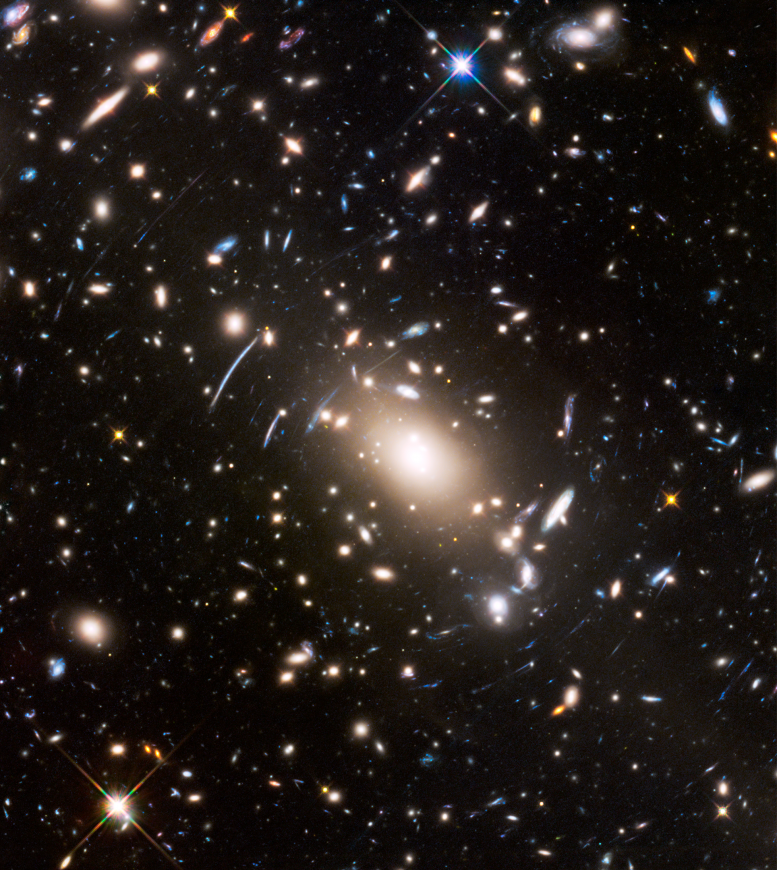
Abell S1063, a galaxy cluster, was observed by the NASA/ESA Hubble Space Telescope as part of the Frontier Fields programme. The huge mass of the cluster acts as a cosmic magnifying glass and enlarges even more distant galaxies, so they become bright enough for Hubble to see. Credit: NASA, ESA, and J. Lotz (STScI)
The team compared the dark-matter maps with samples of simulated galaxy clusters with similar masses, located at roughly the same distances. The clusters in the computer model did not show any of the same level of dark-matter concentration on the smallest scales — the scales associated with individual cluster galaxies.
“The results of these analyses further demonstrate how observations and numerical simulations go hand in hand”, said team member Elena Rasia of the INAF-Astronomical Observatory of Trieste, Italy.
“With advanced cosmological simulations, we can match the quality of observations analyzed in our paper, permitting detailed comparisons like never before,” added Stefano Borgani of the Università degli Studi di Trieste, Italy.
Astronomers, including those of this team, look forward to continuing to probe dark matter and its mysteries in order to finally pin down its nature.
Read Hubble’s Shocking Dark Matter Discovery: Observations Suggest a Missing Ingredient in Cosmic Recipe for more on this discovery.
Reference: “An excess of small-scale gravitational lenses observed in galaxy clusters” by Massimo Meneghetti, Guido Davoli, Pietro Bergamini, Piero Rosati, Priyamvada Natarajan, Carlo Giocoli, Gabriel B. Caminha, R. Benton Metcalf, Elena Rasia, Stefano Borgani, Francesco Calura, Claudio Grillo, Amata Mercurio and Eros Vanzella, 11 September 2020, Science.
DOI: 10.1126/science.aax5164
The Hubble Space Telescope is a project of international cooperation between ESA and NASA.
The international team of astronomers in this study consists of M. Meneghetti, G. Davoli, P. Bergamini, P. Rosati, P. Natarajan, C. Giocoli, G. B. Caminha, R. B. Metcalf, E. Rasia, S. Borgani, F. Calura, C. Grillo, A. Mercurio, and E. Vanzella.
"current" - Google News
September 13, 2020 at 09:10PM
https://ift.tt/32qnzcH
Hubble Uncovers an Unexpected Discrepancy: An Ingredient Missing From Current Dark Matter Theories? - SciTechDaily
"current" - Google News
https://ift.tt/3b2HZto
https://ift.tt/3c3RoCk
Bagikan Berita Ini















0 Response to "Hubble Uncovers an Unexpected Discrepancy: An Ingredient Missing From Current Dark Matter Theories? - SciTechDaily"
Post a Comment